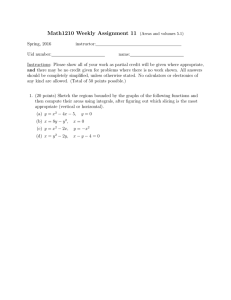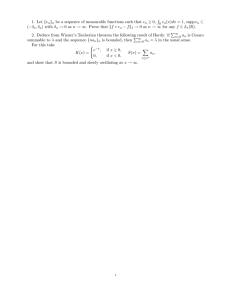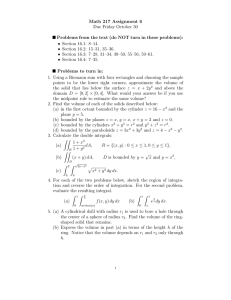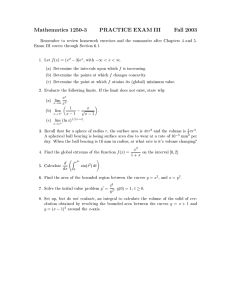Homework 5 Key
advertisement
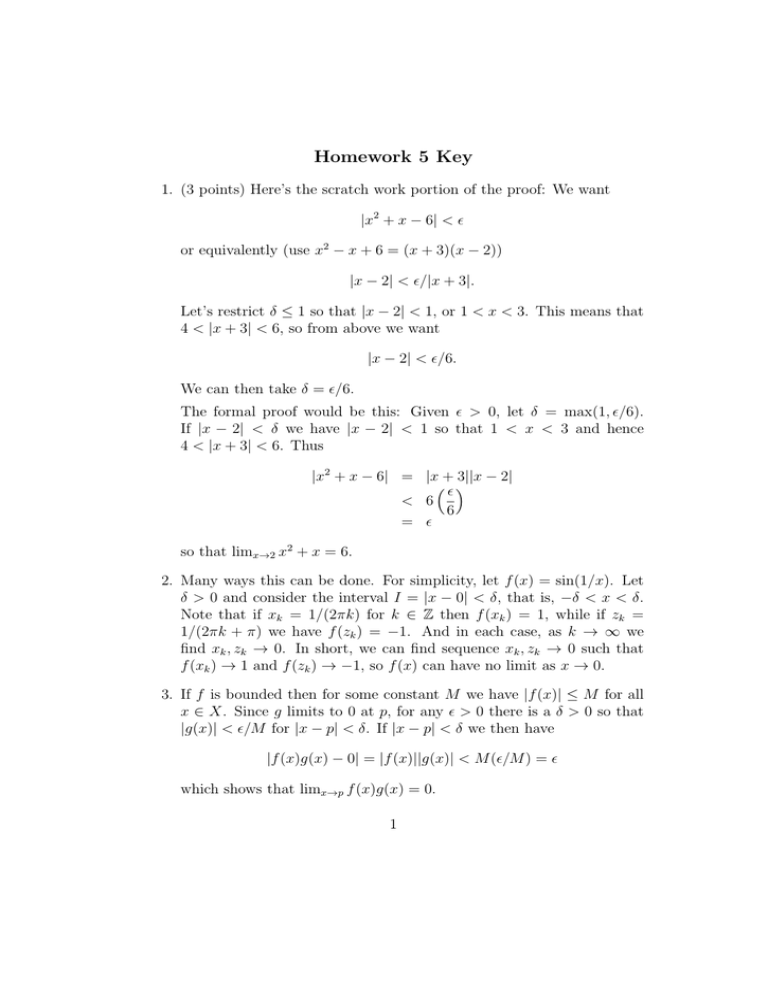
Homework 5 Key
1. (3 points) Here’s the scratch work portion of the proof: We want
|x2 + x − 6| < ϵ
or equivalently (use x2 − x + 6 = (x + 3)(x − 2))
|x − 2| < ϵ/|x + 3|.
Let’s restrict δ ≤ 1 so that |x − 2| < 1, or 1 < x < 3. This means that
4 < |x + 3| < 6, so from above we want
|x − 2| < ϵ/6.
We can then take δ = ϵ/6.
The formal proof would be this: Given ϵ > 0, let δ = max(1, ϵ/6).
If |x − 2| < δ we have |x − 2| < 1 so that 1 < x < 3 and hence
4 < |x + 3| < 6. Thus
|x2 + x − 6| = |x + 3||x − 2|
(ϵ)
< 6
6
= ϵ
so that limx→2 x2 + x = 6.
2. Many ways this can be done. For simplicity, let f (x) = sin(1/x). Let
δ > 0 and consider the interval I = |x − 0| < δ, that is, −δ < x < δ.
Note that if xk = 1/(2πk) for k ∈ Z then f (xk ) = 1, while if zk =
1/(2πk + π) we have f (zk ) = −1. And in each case, as k → ∞ we
find xk , zk → 0. In short, we can find sequence xk , zk → 0 such that
f (xk ) → 1 and f (zk ) → −1, so f (x) can have no limit as x → 0.
3. If f is bounded then for some constant M we have |f (x)| ≤ M for all
x ∈ X. Since g limits to 0 at p, for any ϵ > 0 there is a δ > 0 so that
|g(x)| < ϵ/M for |x − p| < δ. If |x − p| < δ we then have
|f (x)g(x) − 0| = |f (x)||g(x)| < M (ϵ/M ) = ϵ
which shows that limx→p f (x)g(x) = 0.
1
4. A one-liner: Since the set V = {y ∈ R; y ≤ 0} is closed and f is
continuous, the inverse image f −1 (V ) = {x ∈ X : f (x) ∈ V } = {x ∈
X : f (x) ≤ 0} is closed, by Theorem 4.8.
5. (a) Let x be a fixed real number. We can choose a sequence rn of
rational numbers that converge to x. Since f is continuous, f (rn )
converges to f (x). But f (rn ) must converge to zero (since f (rn ) =
0 for all n). Thus f (x) = 0.
(b) Consider the function f −g, for which (f −g)(r) = 0 for all rational
numbers. Part (a) implies (f − g)(x) = 0 for all real x, that is,
f (x) = g(x) for all real x.
6. (a) Let x0 be any point in X. For ϵ > 0 let δ = ϵ. Then for dX (x0 , x) <
δ we have
dX (f (x0 ), f (x)) ≤ cdX (x0 , x) < cδ = cϵ < ϵ.
So f is continuous.
(b) Note that for adjacent terms in the sequence we have
dX (xk , xk+1 ) ≤ cdX (xk−1 , xk ).
A simple induction yields dX (xk , xk+1 ) ≤ ck dX (x0 , x1 ) = ck dX (x0 , f (x0 )).
WLOG assume m < n. By the triangle inequality
n−1
∑
dX (xm , xn ) ≤
dX (xk , xk+1 )
k=m
≤ dX (x0 , f (x0 ))
n−1
∑
ck
k=m
cm − cn
= dX (x0 , f (x0 ))
1−c
1 − cn−m
≤ cm dX (x0 , f (x0 ))
1−c
d
(x
,
f
(x
))
X
0
0
≤ cm
.
1−c
Because |c| < 1 we have cm → 0 as m → ∞. For any ϵ > 0 we
can thus clearly choose some N so that for m ≥ N (and note then
2
n ≥ N ) we have from above dX (xm , xn ) < ϵ. The sequence is thus
Cauchy.
The sequence has a limit because X is complete and the sequence
in Cauchy.
(c) We have
x∗ = lim xk = lim xk+1 = lim f (xk ) = f (x∗ ).
k
k
k
The last equality requires continuity of f .
(d) Suppose another point x = y ∗ satisfies y ∗ = f (y ∗ ). Then
dX (x∗ , y ∗ ) = dX (f (x∗ ), f (y ∗ )) ≤ cdX (x∗ , y ∗ ).
If dX (x∗ , y ∗ ) > 0 we can divide both sides above by dX (x∗ , y ∗ )
and obtain 1 ≤ c, a contradiction. Thus dX (x∗ , y ∗ ) = 0, so that
x∗ = y ∗ .
7. (a) Continuous functions on R map bounded open sets to bounded
open sets: FALSE. Let f be any constant function.
(b) Continuous functions on R map bounded open sets to open sets.
FALSE: Same counterexample.
(c) Continuous functions on R map bounded closed sets to bounded
closed sets. TRUE: Bounded closed sets in R are compact, the
image of a compact set under a continuous function is compact.
(d) Continuous functions on R map bounded closed sets to closed sets.
TRUE: Just a special case of the last question!
8. Note, for example, that p(−2) < 0 while p(0) = 8. By the Intermediate
Value Theorem, there is at least one x ∈ (−2, 0) such that p(x) = 0.
3
